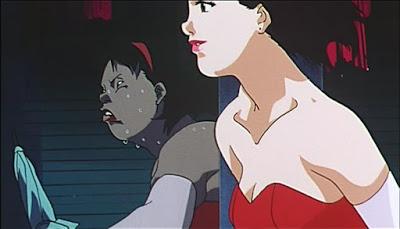Format: DVD from NetFlix on laptop.
This is the tenth in a series of twelve movies suggested by Nick Jobe.

The 1001 Movies list is responsible for my knowledge of a number of directors, directors of whom I would know nothing without having pursued the list. I kind of expected that. In the case of Satoshi Kon, though, I am entirely reliant on Nick Jobe. I’ve seen three of the six films that Kon has directed--Millennium Actress, Tokyo Godfathers, and now Perfect Blue (or Pafekuto Buru) at the behest of Nick. Nick’s various selections for me are entirely responsible for my having seen anything Satoshi Kon is connected to.
Perfect Blue is almost certainly the most influential of Kon’s films, at least in how these are reflected in the work of Darren Aronofsky. Aronofsky has cited Perfect Blue as an influence on Black Swan, and he references shots from this film in Requiem for a Dream. The Black Swan connection is definitely here, although the two films go to different places and get there in different ways.
< For simplicity, I’m going to leave off the names of the voice actors here. I watched the English language version of the film and the folks doing the voices here do fine work, but aren’t recognizable names. Mima Kirigoe is one third of a pop trio called CHAM!, but she wants out and would like to start a new career as an actress. To this end, she has backed out of the group and has managed to get a small part in a crime drama series called Double Bind. At the same time, Mima is being introduced to the internet (it is 1997, after all) where she discovers a website that appears to be written by her about her life.
Mima’s life starts to fragment in odd ways. Her role slowly becomes larger and larger on the television show, but Mima is starting to have waking dreams or hallucinations. Her reflections, always dressed in her CHAM! outfits, start telling her that she’s no longer the real Mima, especially because Mima’s role on the show soon involves a gang rape sequence, which will spoil her pure pop idol image. When she poses nude for a magazine, the splintering continues as her former clean image bumps up against her grittier and more sexual reality.
Throughout Perfect Blue, we are frequently put into positions where we don’t know what is happening and we’re not supposed to know where reality lies. We see Mima speaking to someone about what is happening to her and someone else yells “Cut!” and we’re somewhere different with Mima speaking to someone else about something else. All of this is further complicated by the fact that Mima’s role soon becomes similar to the fragmentation of reality that is happening in her life. When people around her start getting attacked and people connected with the show start turning up dead, everything becomes far more confusing and complicated.
Make no mistake here--Perfect Blue is not intended for children. There’s nudity here and violence, including a couple of very nasty murders. While these gore elements are probably the most notable connection to the horror genre, it’s other aspects of the film that are really what makes Perfect Blue a horror film. This is a psychological thriller where we as the audience are constantly kept guessing not about what will happen next, but about what constitutes reality. The world we are given is consistent, but is also consistently shifting and changing. The horror here is not what happens to the people around Mima, but that her world doesn’t seem to be one where reality is consistent from day to day or moment to moment. By the time we near the end, she is no longer convinced of her own identity or the reality of her own actions.
Perfect Blue comes in at just over 80 minutes long, and that includes the ending credits. Often, that would be a problem, but it’s not one here. The movie moves along at a constant clip, never slowing down for a moment, and despite the short running time, the story it tells is completely satisfying. In fact, I’m not sure that adding five or ten minutes would do anything for the final product. Despite its length, it doesn’t feel pared down or simplified. It’s as long as it needs to be, and not really any longer, even if the last few minutes are a bit compact.
In fact, the only real issues I take with Perfect Blue is that there’s some very weird artwork in places. Mima’s manager Rumi is oddly fish-eyed. That’s even more the case with Mima’s main fan, Mi-Mania, whose eyes are virtually on the side of his head, giving him a near-360-degree field of vision. The Mi-Mania character is supposed to be an unattractive man, but he seriously looks deformed, as does Rumi at times. It seems like an odd choice.
Perfect Blue is a film I’d heard about, and almost everything I’ve heard has been positive. Having seen it now, that’s no longer a surprise as to why. Straight win, Nick, and one of your best choices for this year.
Why to watch Perfect Blue: The story is as good as you’re going to find.
Why not to watch: There’s some very strange and ugly artwork.
